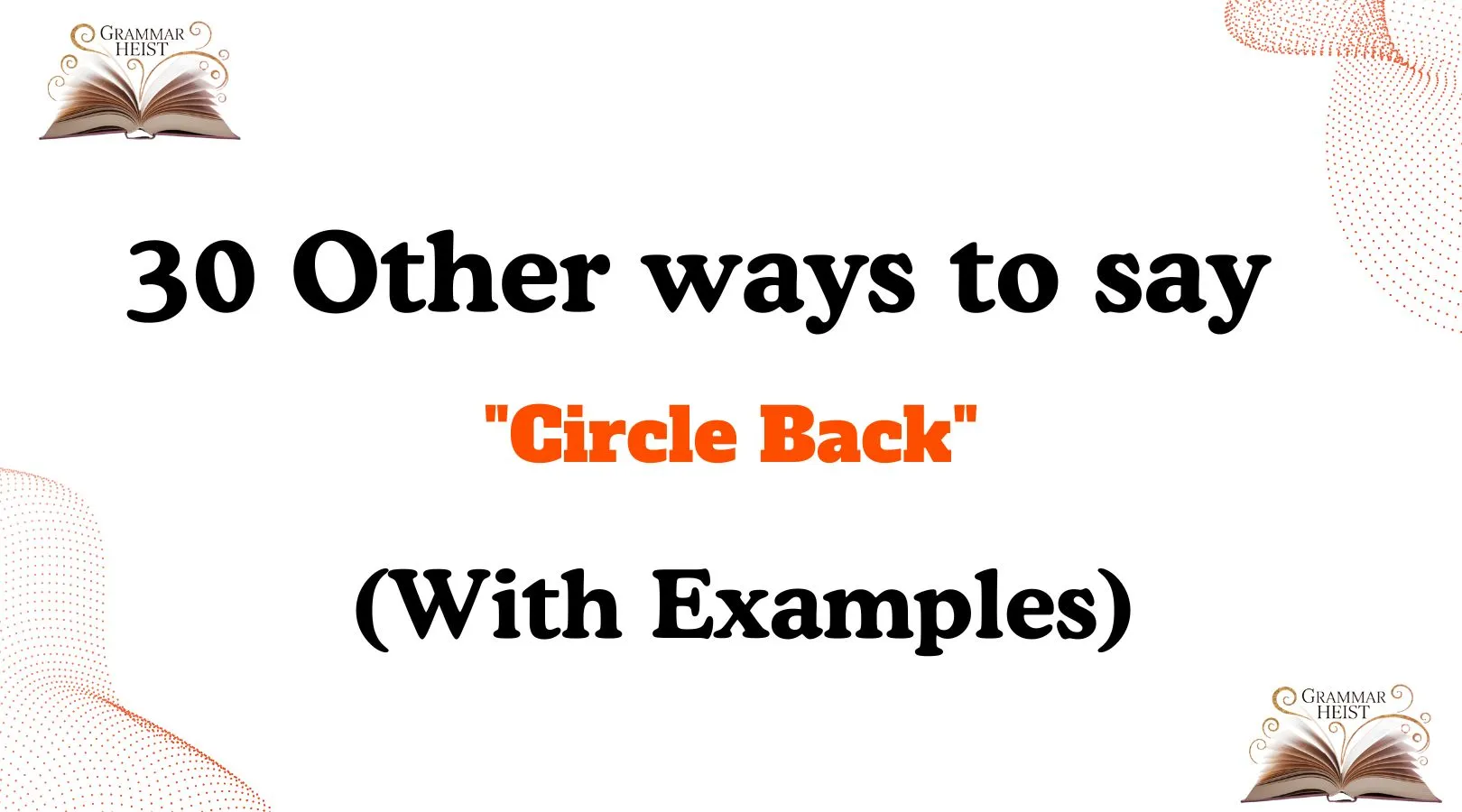Other Ways to Say “Circle Back” are essential in professional communication to avoid repetition and sound more polished. The phrase “circle back” is commonly used in emails and meetings to indicate a follow-up or revisit of a topic. However, using it too often can make your language seem stale or overly corporate.
This is where alternative expressions come in. Replacing “circle back” with other phrases can enhance your communication and better reflect your tone or intent. Some effective synonyms for circle back include “follow up,” “reconnect,” “touch base,” and “check in”. Each phrase can be tailored to suit formal or casual settings.
In this guide, we’ll explore various professional alternatives to circle back that will help you communicate clearly and confidently, whether in business emails, team meetings, or client conversations.
Is It Professional/Polite to Say “Circle Back”?
The phrase “circle back” is polite in most cases and is generally understood to mean returning to a topic or following up on a previous discussion. However, in certain formal settings, it might feel too casual or non-committal. Depending on the context, using more direct or specific alternatives can help ensure the message is clearer and more actionable.
Pros and Cons of “Circle Back”
Pros:
- Simple and easily understood.
- Commonly accepted in informal or internal discussions.
- Flexible for use across a variety of industries.
Cons:
- Can sound vague, with no clear timeline or specific action.
- Overused, making it lose its impact.
- May feel too casual for formal or high-stakes conversations.
Ways to Say “Circle Back”
- A phrase often used in professional settings to mean “return to a topic later.”
- Useful for postponing discussion until more information is available.
- Shows that you’re not ignoring the issue but plan to revisit it.
- Keeps conversations focused and time-efficient.
- Can be used in both meetings and email exchanges.
Synonyms & Alternatives for “Circle Back”
- “Follow up on this.”
- “Revisit the topic.”
- “Get back to this later.”
- “Return to this point.”
- “Check in again.”
How to Say It in Different Ways
- Formal: “Let’s revisit this issue later.”
- Casual: “We’ll get back to this.”
- Direct: “We’ll follow up when we have more details.”
- Polite: “We can return to this at a better time.”
- Professional: “Let’s put this on hold and circle back later.”
Professional Ways to Say “Circle Back”
- “I’ll follow up with you on this.”
- “We should revisit this discussion once we have more data.”
- “I’ll get back to you regarding this matter.”
- “Let’s return to this in our next meeting.”
- “We can table this for now and address it again later.”
What “Circle Back” Means
- It means to postpone a discussion or task until a more suitable time.
- Suggests the issue isn’t closed, just delayed.
- Often used to manage priorities in meetings or emails.
- Implies responsibility to check in again later.
- Helps keep communication structured and efficient.
How to Respond to “Circle Back”
- “Sounds good, let’s revisit it then.”
- “Okay, I’ll wait for your follow-up.”
- “Sure, we can pick this up later.”
- “Noted, I’ll prepare more details before then.”
- “Thanks, I’ll look forward to continuing the discussion.”
“circle back” Synonyms:
- Follow Up
- Check In
- Reconnect
- Get Back to
- Touch Base
- Reconnect with
- Review
- Revisit
- Reevaluate
- Look Into
- Follow Through
- Check Back
- Get In Touch
- Give an Update
- Touch In
- Set Up a Time to Discuss
- Update
- Follow-Up With
- Get the Ball Rolling
- Reconfirm
- Follow Up
- Check In
- Reconnect
- Get Back to
- Touch Base
- Reconnect with
- Review
- Revisit
- Reevaluate
- Look Into
1. “Follow Up”
Scenario: When you want to revisit a topic or update someone.
Examples:
- “I’ll follow up with you on this next week.”
- “Let’s follow up after the meeting to finalize the details.”
- “I’ll follow up to ensure we’re on track.”
Tone: Neutral, professional.
Explanation: A direct and clear alternative, commonly used in both formal and informal contexts. It communicates the action of revisiting a matter or providing additional information.
2. “Check In”
Scenario: When you want to reconnect or verify progress on something.
Examples:
- “I’ll check in with you after the presentation.”
- “Let’s check in next week to see how things are going.”
- “I’ll check in later to get an update on the status.”
Tone: Friendly, approachable.
Explanation: This phrase conveys a more casual and collaborative tone, ideal for building ongoing communication and ensuring follow-up.
3. “Reconnect”
Scenario: When you plan to resume communication or discuss something previously left unresolved.
Examples:
- “Let’s reconnect tomorrow to finalize the plan.”
- “I’ll reconnect with you once I have more information.”
- “We should reconnect after the holidays to see where we stand.”
Tone: Positive, professional.
Explanation: This is a gentler, more personal alternative that emphasizes a desire to resume or re-establish communication.
4. “Get Back to”
Scenario: When you plan to respond or address something at a later time.
Examples:
- “I’ll get back to you once I have the details.”
- “Let me get back to you after I’ve had a chance to review this.”
- “I’ll get back to you later today with an update.”
Tone: Professional, assertive.
Explanation: This alternative is clear and actionable, focusing on the idea of returning to a matter after addressing something else.
5. “Touch Base”
Scenario: When you plan to briefly connect or provide an update.
Examples:
- “Let’s touch base on this after the meeting.”
- “I’ll touch base with you next week regarding the proposal.”
- “Let’s touch base soon to review the progress.”
Tone: Friendly, collaborative.
Explanation: This phrase suggests a brief and informal check-in, often used to gauge progress or clarify small details.
6. “Reconnect with”
Scenario: When you plan to return to a topic or person after a period of time.
Examples:
- “I’ll reconnect with you after I speak with the team.”
- “Let me reconnect with you once we have more clarity.”
- “We’ll reconnect next week to discuss the next steps.”
Tone: Professional, considerate.
Explanation: A variation of “reconnect,” this phrase is a bit more formal and can be used in both professional and personal contexts.
7. “Review”
Scenario: When you need to revisit a subject for further consideration.
Examples:
- “I’ll review this and get back to you by the end of the day.”
- “Let’s review the plan in our next meeting.”
- “I’ll review the document and update you tomorrow.”
Tone: Neutral, professional.
Explanation: This phrase is more specific and used when revisiting something that requires deeper thought or analysis.
8. “Revisit”
Scenario: When you want to go over something again to reconsider or address additional points.
Examples:
- “Let’s revisit the discussion after we gather more data.”
- “I’ll revisit the details and follow up with an answer.”
- “We can revisit this issue once we get feedback from the client.”
Tone: Professional, considerate.
Explanation: This phrase suggests a careful re-examination, ideal for more formal or serious discussions that require careful thought.
9. “Reevaluate”
Scenario: When you need to assess something again, typically in response to new information.
Examples:
- “I’ll reevaluate the proposal and get back to you shortly.”
- “Let’s reevaluate the plan after we have more data.”
- “I’ll reevaluate the priorities before our next meeting.”
Tone: Analytical, thoughtful.
Explanation: This phrase emphasizes a more critical, objective re-examination, making it great for when careful judgment is needed.
10. “Look Into”
Scenario: When you need to gather more information before making a final decision.
Examples:
- “I’ll look into it and get back to you with an update.”
- “Let’s look into the options and revisit this next week.”
- “I’ll look into the issue and report back to you.”
Tone: Neutral, action-oriented.
Explanation: A more proactive alternative, implying the need for additional research or consideration before providing an answer.
11. “Follow Through”
Scenario: When you are committed to completing a task or revisiting a subject.
Examples:
- “I will follow through on this and provide an update tomorrow.”
- “Let’s follow through and finalize the report this afternoon.”
- “I will follow through on our discussion and get back to you soon.”
Tone: Professional, decisive.
Explanation: This phrase emphasizes completing an action and ensuring tasks or commitments are carried out thoroughly.
12. “Check Back”
Scenario: When you intend to return to someone or something after some time for further review or response.
Examples:
- “I will check back with you once I’ve received the feedback.”
- “Let’s check back later in the week to see if there are any updates.”
- “I’ll check back after I’ve had a chance to speak with the team.”
Tone: Neutral, approachable.
Explanation: “Check back” conveys the intention to revisit a matter without implying that the situation is urgent or critical.
13. “Get In Touch”
Scenario: When you plan to contact someone for further discussion or clarification.
Examples:
- “I’ll get in touch with you next week to see where we stand.”
- “I will get in touch after I’ve gathered more information.”
- “We can get in touch to finalize the details as soon as possible.”
Tone: Friendly, professional.
Explanation: A polite and direct phrase to indicate that you plan to reach out or reconnect in the future.
14. “Give an Update”
Scenario: When you plan to provide more information or progress about a task.
Examples:
- “I’ll give you an update once I’ve completed the review.”
- “Let’s give an update at our next meeting on where we are with the project.”
- “I’ll give an update after I speak with the client.”
Tone: Neutral, professional.
Explanation: This alternative focuses on providing new information or progress in a clear, structured way.
15. “Touch In”
Scenario: When you need to check in or verify progress on a matter.
Examples:
- “I’ll touch in with you tomorrow to see if there’s anything new.”
- “Let’s touch in after the meeting to discuss any new developments.”
- “I’ll touch in with the team to ensure everything is on track.”
Tone: Casual, approachable.
Explanation: This phrase is often used for brief, informal check-ins, offering a sense of collaboration and ongoing communication.
16. “Set Up a Time to Discuss”
Scenario: When you want to schedule a specific time to revisit a matter.
Examples:
- “Let’s set up a time to discuss the next steps next week.”
- “We should set up a time to discuss the project details further.”
- “I’ll set up a time to discuss the issues you raised during our meeting.”
Tone: Professional, organized.
Explanation: This phrase ensures that discussions will be planned and scheduled, offering a clear action item for the future.
17. “Update”
Scenario: When you want to bring someone up to speed on new developments.
Examples:
- “I’ll update you once I have the requested information.”
- “Let’s update each other next week on the progress of our tasks.”
- “I’ll update you as soon as I receive the necessary approvals.”
Tone: Neutral, informative.
Explanation: This phrase is brief and to the point, perfect for providing new information without unnecessary detail.
18. “Follow-Up With”
Scenario: When you plan to reach out or check back on something.
Examples:
- “I’ll follow up with you after I speak with the department head.”
- “I’ll follow up with the client to confirm the details.”
- “Let me follow up with you by the end of the day with an update.”
Tone: Neutral, professional.
Explanation: This variation is slightly more formal than “check in” and implies a more detailed or thoughtful follow-up.
19. “Get the Ball Rolling”
Scenario: When you want to initiate a project or action that will lead to further steps.
Examples:
- “Let’s get the ball rolling by setting up a meeting next week.”
- “I’ll get the ball rolling on the next phase once I receive approval.”
- “We need to get the ball rolling on this project if we want to meet the deadline.”
Tone: Energetic, proactive.
Explanation: This phrase conveys momentum and action, signaling that you intend to begin working on something and make progress quickly.
20. “Reconfirm”
Scenario: When you want to double-check or verify something before moving forward.
Examples:
- “I’ll reconfirm the meeting time and let you know.”
- “Let me reconfirm the details before we proceed.”
- “I’ll reconfirm the numbers and follow up with you later.”
Tone: Precise, professional.
Explanation: This phrase is used to ensure accuracy and give confirmation that the matter is being revisited for clarity.
21. “Follow Up”
Scenario: When you need to revisit or address something after time has passed.
Examples:
- “I’ll follow up on this matter by next Tuesday.”
- “Let’s follow up with the client next week to check their response.”
- “I will follow up with more details after I check in with the team.”
Tone: Neutral, professional.
Explanation: This phrase keeps the focus on action and is effective for tracking progress or confirming details.
22. “Check In”
Scenario: When you intend to make sure everything is on track or revisit something for more details.
Examples:
- “I’ll check in next week to see how things are going.”
- “Let’s check in after the presentation to discuss next steps.”
- “I’ll check in with the team and get back to you.”
Tone: Friendly, approachable.
Explanation: This expression emphasizes a gentle and ongoing interaction, ideal for creating open communication.
23. “Reconnect”
Scenario: When you want to re-establish contact after a period of time.
Examples:
- “Let’s reconnect after the holiday break to go over everything.”
- “I’ll reconnect with you once I have the final numbers.”
- “We’ll reconnect next month to review the progress.”
Tone: Warm, positive.
Explanation: “Reconnect” conveys the idea of re-establishing communication with a personal, friendly touch.
24. “Get Back to”
Scenario: When you plan to respond to someone or revisit a matter.
Examples:
- “I’ll get back to you with the full report by the end of the day.”
- “Let’s get back to the issue after we finish the meeting.”
- “I’ll get back to you on this after I finish reviewing the details.”
Tone: Professional, concise.
Explanation: A clear alternative that conveys responsibility and commitment to follow through.
25. “Touch Base”
Scenario: When you want to have a brief check-in or conversation about a topic.
Examples:
- “Let’s touch base tomorrow and finalize the details.”
- “I’ll touch base with you after I finish the review.”
- “We should touch base to make sure we’re all aligned.”
Tone: Casual, collaborative.
Explanation: This phrase suggests light, informal interaction to ensure everyone is on the same page.
26. “Reconnect With”
Scenario: When you need to return to a topic or conversation after it has been temporarily paused.
Examples:
- “Let’s reconnect with the team to finalize the project timeline.”
- “I’ll reconnect with you once I get feedback from the client.”
- “We’ll reconnect with you after we’ve had time to review the proposal.”
Tone: Respectful, professional.
Explanation: “Reconnect with” is great for restarting a discussion or revisiting something that requires further attention.
27. “Review”
Scenario: When you want to revisit information for further analysis or discussion.
Examples:
- “I’ll review the report and get back to you soon.”
- “Let’s review the contract before we sign it.”
- “I’ll review the details and follow up with my recommendations.”
Tone: Formal, thorough.
Explanation: “Review” is ideal for formal re-examinations or checking over details that require careful consideration.
28. “Revisit”
Scenario: When you need to reconsider or address something again after some time.
Examples:
- “We can revisit the proposal after we get more information.”
- “I’ll revisit this issue after I speak with the manager.”
- “Let’s revisit the plan once we’ve received the client’s feedback.”
Tone: Thoughtful, professional.
Explanation: A great choice for revisiting something that might require further evaluation or discussion.
29. “Reevaluate”
Scenario: When you want to assess something again, possibly in light of new information.
Examples:
- “Let’s reevaluate the situation after we gather more data.”
- “I’ll reevaluate the strategy before making any changes.”
- “We should reevaluate the timeline and adjust if necessary.”
Tone: Analytical, serious.
Explanation: This phrase implies a careful reassessment, ideal when the previous information needs reconsideration.
30. “Look Into”
Scenario: When you need to investigate or explore something further.
Examples:
- “I’ll look into the issue and follow up with you shortly.”
- “Let me look into this matter and get back to you with answers.”
- “We can look into the options and revisit this later.”
Tone: Actionable, professional.
Explanation: This phrase suggests a proactive investigation and emphasizes gathering information before making a decision.
Conclusion
The right alternative to “circle back” will depend on the context of your conversation and the tone you want to set. By using these 30 alternatives, you can keep your communication clear, precise, and engaging, whether you’re handling follow-ups, check-ins, or revisiting important topics. These phrases will allow you to communicate with professionalism while maintaining warmth and clarity.
Most Popular:
30 Other Ways to Say “Thanks for Having Me” (With Examples)
30 Other Ways to Say “Someone Left the Company” (With Examples)
30 Other Ways to Say “Kindly Request” (With Examples)
30 Other Ways to Say “I Am Honored” (With Examples)
30 Other Ways to Say ‘Are We Still On’ (With Examples)
30 Other Ways to Say ‘When Is a Good Time’ (With Examples)
30 Other Ways to Say “Mind Your Own Business” (With Examples)
30 Other Ways to Say “Thank You for the Explanation” (With Examples)

Emma Brooke is a passionate advocate for effective communication and language mastery. As a dedicated professional in the field of grammar and writing, Emma brings a wealth of knowledge and expertise to those seeking to improve their linguistic skills. With a focus on clarity, precision, and style, Emma Brooke is committed to helping individuals refine their language use to communicate confidently and effectively.












